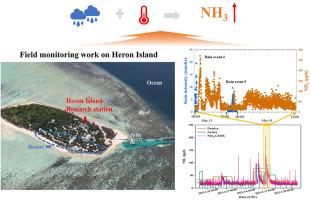大堡礁一个鸟类丰富的岛屿上的氨排放:环境驱动因素和观察见解
IF 3.7
2区 环境科学与生态学
Q2 ENVIRONMENTAL SCIENCES
引用次数: 0
摘要
氨是大气中关键的碱性气体,在新粒子形成和云凝结核活动中起着重要作用,特别是在海洋环境中。在鸟类丰富的岛屿上,氨的排放量往往超过城市地区,并受到温度和降水等环境因素的影响。本研究采用离线主动采样、离线被动采样和在线硝酸盐化学电离质谱(NO3-CIMS)三种不同的方法对大堡礁Heron岛NH3排放进行了调查。在采样期间,主动采样、被动采样和NO3-CIMS的平均NH3混合比分别为29±23 ppb、29±22 ppb和39±19 ppb。结果表明,三种方法的NH3混合比趋势一致。NH3混合比的变化与降水事件高度相关。降水期间,NH3混合比在降雨后30 min至数h内显著增加。室内鸟粪实验进一步证明,降水对NH3排放的影响大于温度。此外,被动采样器测得的δ15N-NH3值(- 19.5‰~ - 11.7‰)与NH3水平呈负相关,证实了海鸟粪便是NH3的主要来源。这些发现强调了NH3排放的动态行为及其对环境因子的敏感性,揭示了大堡礁生态系统对与气溶胶形成相关的大气过程的潜在重要性。本文章由计算机程序翻译,如有差异,请以英文原文为准。

Ammonia emissions from an avian-rich island in the Great Barrier Reef: Environmental drivers and observational insights
Ammonia, a key alkaline gas in the atmosphere, plays a significant role in new particle formation and cloud condensation nuclei activity, particularly in marine environments. On islands rich in avian fauna, ammonia emissions often exceed those in urban areas and are influenced by environmental factors such as temperature and precipitation. This study investigated the NH3 emissions on Heron Island in the Great Barrier Reef using three different methods, namely offline active sampling, offline passive sampling, and online nitrate chemical ionization mass spectrometry (NO3-CIMS). The average NH3 mixing ratio of active sampling, passive sampling, and NO3-CIMS during the sampling period was 29 ± 23 ppb, 29 ± 22 ppb, and 39 ± 19 ppb. Results from the three methods revealed consistent NH3 mixing ratio trends. Changes in NH3 mixing ratio were highly correlated with precipitation events. During precipitation periods, the NH3 mixing ratio increased significantly within 30 min to a few hours after the rain started. Laboratory bird guano experiments further proved that NH3 emissions are more influenced by precipitation than temperature. Besides, the δ15N-NH3 values (−19.5 ‰ to −11.7 ‰) measured by passive samplers negatively correlated with NH3 levels, confirming seabird guano as the primary NH3 source. These findings highlighted the dynamic behavior of NH3 emissions and their sensitivity to environmental factors, shedding light on the potential importance of the Great Barrier Reef ecosystem for atmospheric processes relevant to aerosol formation.
求助全文
通过发布文献求助,成功后即可免费获取论文全文。
去求助
来源期刊

Atmospheric Environment
环境科学-环境科学
CiteScore
9.40
自引率
8.00%
发文量
458
审稿时长
53 days
期刊介绍:
Atmospheric Environment has an open access mirror journal Atmospheric Environment: X, sharing the same aims and scope, editorial team, submission system and rigorous peer review.
Atmospheric Environment is the international journal for scientists in different disciplines related to atmospheric composition and its impacts. The journal publishes scientific articles with atmospheric relevance of emissions and depositions of gaseous and particulate compounds, chemical processes and physical effects in the atmosphere, as well as impacts of the changing atmospheric composition on human health, air quality, climate change, and ecosystems.
 求助内容:
求助内容: 应助结果提醒方式:
应助结果提醒方式:


